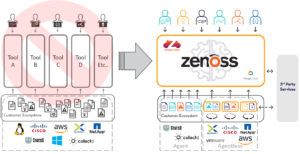It’s official: Legacy IT infrastructure management (ITIM) tools have finally met their end. Several factors are combining to make existing on-premises ITIM tools nonviable in the presence of new cloud-based offerings. First and foremost, a slow but steady transition to generalists from specialists has left IT organizations with fewer experts required to manage a complex management tool. And second, legacy on-premises tools are not equipped to handle the data explosion occurring with ephemeral entities and expansion of infrastructure across clouds. In addition, new continuous integration/continuous deployment (CI/CD) methodologies have rendered last generation’s tools completely lacking in the ability to facilitate rapid application pushes and subsequent troubleshooting in real time.
The Merge
With traditional IT operations teams assimilating DevOps teams (and vice versa), the need has never been greater for combined toolsets that facilitate rapid change in place of previous norms of “keeping the lights on.” For all but a few mega-scale web (only) companies, the IT infrastructure for all of these applications spans across traditional data center equipment, newer hyperconverged infrastructure, and an ever ever-growing incursion across multiple public cloud vendors. The key element in managing this entire environment is quality data collection combined with the ability to derive insights across these isolated infrastructure landscapes. Collecting information from all of these disparate settings is often initially performed with vendor-provided tools, but these individual tools lack the ability to create domain-spanning awareness. In addition, vendor-based and legacy on-premises IT operations tools lack the simplicity and ease of use necessary to attract developers who have now become a fundamental staple of the operations team. With these same developers deploying code daily, if not hourly, the need for self-served management tools has never been greater — and given the transitory nature of today’s infrastructure, service operators/developers need the ability to query within the full context of the environment to troubleshoot and enable health-ensuring automation.
Cloud-First and Machine Learning
Metics, events, logs, etc. — IT organizations are generating enough machine data to fill data lakes the size of Lake Superior, and static, on-premises storage solutions can rarely scale to these ever-growing needs. (An IT pro who counters this assertion will simultaneously have to confess to the intense human and dollar tolls required to keep said on-premises tools running.) However, handling the capacity needs for a flood of real-time streaming data is only part of the challenge considering that scalable, machine-derived learning must occur to make sense of it all. As with decision-making in human settings, context is a critical element in gaining trust, and often, the lack of context within a specific tool causes operators to distrust resultant automation (or abandon it altogether). To obtain the full context, information from the deep infrastructure, where agentless collection behind the firewall is required, must be combined with information from the shallow parts of the infrastructure, where agents are often required for security perimeters and/or more real-time collection. Stitching these two related but often isolated data sets requires machine learning to color the information for consumption by humans and by future remediation automation.
Hope Has Arrived
The last thing DevOps engineers want to deal with is managing a disparate set of management tools (even when they share the same logo) alongside the more pressing needs of improving a revenue-generating application, which has its own internal challenges. Application operators, whether rooted in IT operations or DevOps, need a tool that a) covers any and all data ingests in terms of scale and breadth, b) incorporates machine-based learnings colored with the crowdsourced knowledge of SMEs, and c) provides a legitimate road map for autonomous operations in the future. In addition, they need tools that are always available with constantly evolving security advancements without having to deal with upgrades, maintenance and support.
For many organizations, Zenoss Cloud meets all of these requirements and provides a cloud-first replacement strategy for on-premises toolsets that have struggled to keep pace with the CI/CD needs of DevOps organizations. For more information on how Zenoss Cloud can help you bridge the gap from traditional IT operations with your DevOps needs, feel free to schedule a demo today.









